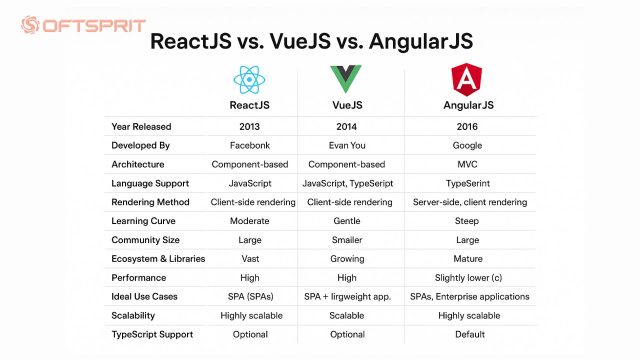Best Front Framework To Choose in 2025
1. Introduction
Quick background on JavaScript frameworks :JavaScript libraries and frameworks have significantly simplified website and application development by offering a broad range of powerful features and functionalities.
Originally designed for client-side scripting, JavaScript has evolved to become a versatile language that now powers server-side development as well. In essence, JavaScript has firmly established itself as the language of the web, enabling developers to build dynamic, interactive, and scalable web applications across the entire technology stack. Javascript is also growing with Ai and we can check growing ai tools
1.1 What Are JavaScript Libraries?
They provide practical tools that simplify common programming challenges, helping developers add features quickly and efficiently.
On the other hand, JavaScript frameworks offer a more comprehensive structure. They consist of multiple libraries combined into a cohesive platform that supports the development of particular types of applications. Frameworks provide a solid foundation with built-in functionality tailored to the needs of developers working on complex projects.
By using JavaScript frameworks, developers don’t have to start coding from scratch. Instead, they can build upon an established base, which accelerates development, ensures consistency, and promotes best practices. This foundational support allows developers to focus more on unique application features rather than reinventing core functionalities, ultimately streamlining the creation of robust and scalable JavaScript applications.
1.2 Brief history of React, Vue, and Angular.
Angular is a powerful framework developed by Google and released in 2010, making it the oldest among the three popular JavaScript frameworks. Built with TypeScript, Angular provides a comprehensive platform for building large-scale web applications. It is open-source and distributed under the permissive MIT license, which allows developers significant freedom to reuse and modify the code.
React, developed by Facebook in 2013, is technically a JavaScript library rather than a full framework. It has gained immense popularity for building complex and dynamic user interfaces. React also operates under the MIT license, ensuring flexible use. Facebook leverages React and its mobile counterpart, React Native, in major products like WhatsApp, Facebook, and Instagram, demonstrating its robustness and scalability.
Vue is the youngest framework in this group, created in 2014 by Evan You, a former Google engineer. Vue has quickly grown in popularity due to its simplicity and gentle learning curve. Like Angular and React, Vue is open-source and uses the MIT license, encouraging widespread adoption and community contributions.
2 Is React still worth learning in 2025?
eact.js (commonly known as React) is a popular JavaScript library focused on building dynamic user interfaces (UIs). It is especially well-suited for single-page applications (SPAs), where content updates seamlessly without requiring full page reloads. React’s component-based architecture allows developers to create reusable UI elements, making the development process more efficient and scalable.
2.1 why we choose Reactjs over other framework ?
Choosing ReactJS over other frameworks for web development is often based on several key advantages:
- Component-Based Architecture:
React encourages developers to build user interfaces using reusable, self-contained components. This modular approach improves code organization, simplifies development, and makes managing complex applications much easier. - Virtual DOM for Enhanced Performance:
React employs a Virtual DOM—a lightweight, in-memory representation of the real DOM. When the application state changes, React calculates the minimal updates needed and efficiently applies them to the actual DOM. This process results in faster rendering and better overall application performance compared to traditional DOM manipulation. - Flexibility and Simplicity:
Focusing primarily on the “view” layer, React offers developers the freedom to integrate other libraries and tools for routing, state management, and more. Its declarative syntax with JSX makes building and understanding UIs straightforward and intuitive. - Strong Community and Ecosystem:
React benefits from a large, active community that provides extensive documentation, a wide array of third-party libraries, and tools. This vibrant ecosystem accelerates development by offering ready-made solutions to common challenges. - Reusable Components:
The component-based design enables creating reusable UI elements, reducing development time and ensuring consistency across different sections of an app or even multiple projects
3 What is Vuejs?
Vue.js, commonly known as Vue, is an open-source progressive JavaScript framework designed for building user interfaces and single-page applications (SPAs). Its incremental adoptability allows developers to use Vue as a simple library for small projects or scale it into a full-featured framework for complex applications.
Vue offers a rich set of built-in directives as well as support for custom directives, enabling developers to extend its functionality easily. Built around the Model-View-ViewModel (MVVM) architectural pattern, Vue provides a clean and efficient structure for developing high-quality, reactive user interfaces and engaging SPAs.
With its gentle learning curve and flexibility, Vue has become a favorite among developers looking to create fast, maintainable, and scalable web applications.
3.1 why we choose Vuejs over other framework?
- Ease of Learning and Use:
Vue.js is widely appreciated for its gentle learning curve, especially for developers already familiar with HTML, CSS, and JavaScript. Its clear, comprehensive documentation and intuitive API make it easy to get started and quickly become productive. - Progressive Adaptability:
Designed to be progressively adoptable, Vue.js allows developers to integrate it into existing projects incrementally. This means you can add interactive features to parts of an application without a complete rewrite, or scale it up to build full-fledged Single Page Applications (SPAs). - Performance and Lightweight Nature:
Vue.js is lightweight and performs efficiently, thanks to its optimized virtual DOM and reactive data system. Its small bundle size helps reduce loading times, ensuring faster and smoother user experiences. - Flexibility and Organized Structure:
With a strong emphasis on a component-based architecture, Vue.js promotes reusable and modular code, improving maintainability and scalability. Single-file components—combining HTML, CSS, and JavaScript in one file—make development clean and organized. - Well-Defined Ecosystem:
Vue offers a robust and actively maintained ecosystem, including official libraries like Vue Router for navigation and Pinia (or Vuex) for state management. This integrated ecosystem simplifies development by reducing reliance on third-party tools.
4 What is Angularjs ?
Angular is a popular open-source framework designed for developing scalable web applications, especially single-page applications (SPAs). Created and supported by Google, Angular is built using TypeScript and leverages HTML templates to define the structure and layout of the user interface.
4.1 why we choose Angularjs over other framework?
AngularJS, while an older framework compared to its successor Angular, was chosen by developers for several reasons, particularly for building dynamic single-page applications (SPAs):
- Comprehensive Framework:
AngularJS is a full-featured, all-in-one framework that provides built-in solutions for routing, form validation, HTTP requests, and more. This reduces the need for integrating multiple third-party libraries, simplifying development. - Two-Way Data Binding:
One of AngularJS’s standout features is its two-way data binding, which keeps the model and view in sync automatically. This makes it easier to build dynamic, real-time applications with less boilerplate code. - Dependency Injection:
AngularJS includes a powerful dependency injection system that improves code modularity and testability, allowing developers to write cleaner, more maintainable code. - Community and Support:
Maintained by Google and backed by a strong developer community, AngularJS benefits from extensive documentation, regular updates, and a wealth of resources for learning and troubleshooting. - MVC Architecture:
AngularJS follows the Model-View-Controller (MVC) pattern, which helps separate concerns within the application, making the code more organized and scalable. - Declarative UI:
With AngularJS, developers can create dynamic user interfaces using declarative HTML templates, which simplifies the development process and improves readability.
5 Reactjs vs Vuejs vs Angularjs ?

6 Conclusion
In 2025, the best framework for you ultimately depends on your goals, project needs, and personal learning style. ReactJS (React.js), the leading JavaScript library in 2025, remains the top choice among front-end developers for building dynamic user interfaces for flexibility, community support, and a vast ecosystem, making it ideal for developers who want freedom in building modern, scalable UIs. Angular, with its opinionated and complete framework approach, is best suited for large-scale enterprise applications that demand strong structure and TypeScript integration.
Whichever you choose, remember that the core skills you develop—problem-solving, clean coding practices, and understanding JavaScript fundamentals—will always be more valuable than the framework itself.
In the competitive world of front-end development in 2025, JavaScript frameworks like React, Vue, and Angular dominate the landscape for building scalable web apps and single-page applications (SPAs).







